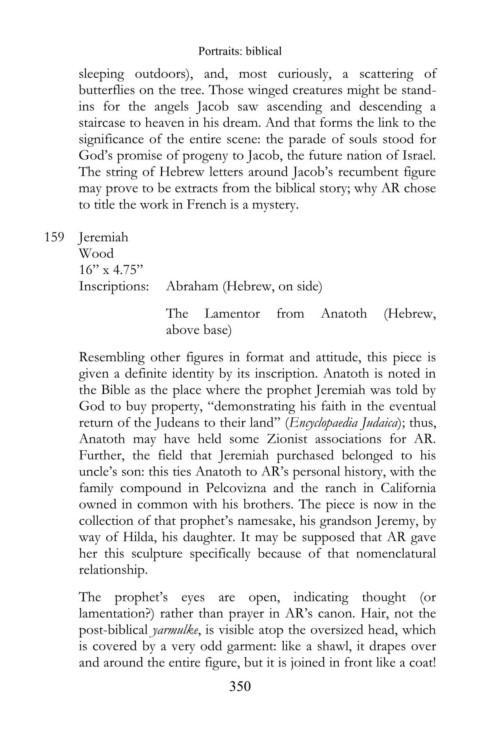Page 354 - The Legacy of Abraham Rothstein - text
P. 354
Portraits: biblical
sleeping outdoors), and, most curiously, a scattering of
butterflies on the tree. Those winged creatures might be stand-
ins for the angels Jacob saw ascending and descending a
staircase to heaven in his dream. And that forms the link to the
significance of the entire scene: the parade of souls stood for
God’s promise of progeny to Jacob, the future nation of Israel.
The string of Hebrew letters around Jacob’s recumbent figure
may prove to be extracts from the biblical story; why AR chose
to title the work in French is a mystery.
159 Jeremiah
Wood
16” x 4.75”
Inscriptions: Abraham (Hebrew, on side)
The Lamentor from Anatoth (Hebrew,
above base)
Resembling other figures in format and attitude, this piece is
given a definite identity by its inscription. Anatoth is noted in
the Bible as the place where the prophet Jeremiah was told by
God to buy property, “demonstrating his faith in the eventual
return of the Judeans to their land” (Encyclopaedia Judaica); thus,
Anatoth may have held some Zionist associations for AR.
Further, the field that Jeremiah purchased belonged to his
uncle’s son: this ties Anatoth to AR’s personal history, with the
family compound in Pelcovizna and the ranch in California
owned in common with his brothers. The piece is now in the
collection of that prophet’s namesake, his grandson Jeremy, by
way of Hilda, his daughter. It may be supposed that AR gave
her this sculpture specifically because of that nomenclatural
relationship.
The prophet’s eyes are open, indicating thought (or
lamentation?) rather than prayer in AR’s canon. Hair, not the
post-biblical yarmulke, is visible atop the oversized head, which
is covered by a very odd garment: like a shawl, it drapes over
and around the entire figure, but it is joined in front like a coat!
350

